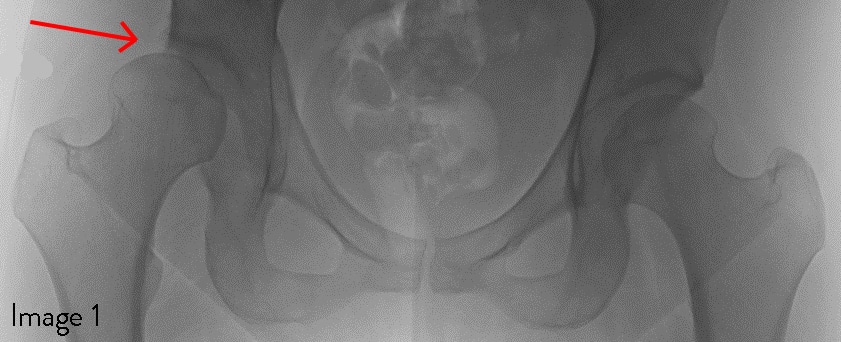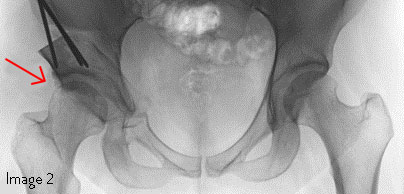Periacetabular Osteotomy – Overview
Periacetabular osteotomy is a surgery carried out to treat a condition called hip dysplasia. Hip dysplasia is an abnormality of the hip joint where the acetabulum (socket) does not fully cover the femoral head (ball), resulting in an increased risk for joint dislocation and osteoarthritis.
Symptoms of this condition – which may be present from birth but may only become evident in adolescence or adulthood – generally include hip pain and restricted mobility. If left untreated, hip dysplasia may result in complications such as arthritis, limping and low back pain.
In periacetabular osteotomy (PAO), the bone around the acetabulum is cut and then realigned so that it provides better coverage for the femoral head, thereby improving hip stability and decreasing hip pain.
Surgical Procedure for Periacetabular Osteotomy (PAO)

The red arrow points to the dysplasia of the right hip. Compared to the normal left hip, the right femoral head is not covered by the acetabulum and is starting to slip upwards and out of the socket.

The red arrow points to the right hip after a PAO has been performed. The femoral head is now properly covered and moved downwards and into the acetabulum.
Many patients with mild forms of hip dysplasia undergo a trial of nonsurgical treatment with steroid injections and physical therapy. When this approach is successful, the patient is followed with a series of magnetic resonance images (MRIs) to make sure that there is no progression of damage in the joint.
For patients with long histories of symptoms or more severe forms of dysplasia, the periacetabular osteotomy is usually recommended at the outset, as long as the extent of hip joint arthritis is not too advanced or severe.
The PAO preserves the integrity of the pelvic ring but allows precise and full correction of even severe hip dysplasia. It involves cutting the pelvis around the entire acetabulum, which is then repositioned into a position that better covers the femoral head. Usually, 3 or 4 screws are used to hold the acetabulum in its new position. Over time, new bone will grow where the cuts are made, fusing the acetabulum to the rest of the pelvis.
Hip arthroscopy may also be performed along with a PAO in selected patients (for example, to repair a damaged labrum).
More: Types of Hip Surgery
Periacetabular Osteotomy Risks and Complications
Like all types of surgery, PAO has its risks and complications. They include:
- Bleeding
- Infection
- Dysesthesia – an abnormal unpleasant sensation felt when touched caused by damage to the lateral femoral cutaneous nerve.
- Recurrent labral tear
- Complex regional pain syndrome
All complications are usually not serious and often resolve without any permanent physical damage.
Periacetabular Osteotomy Cost
The total cost for periacetabular osteotomy depends on a lot of factors such as the anesthetic fee, private hospital fee, private operating facility fee, and the extent of surgery required. The total cost of the procedure is around $6500 – $7500.
Periacetabular Osteotomy Recovery
The recovery and expectations for patients who have a PAO performed are:
- In the hospital for 3-5 days after surgery
- Walking and using crutches 1-2 days after surgery
- Using crutches for 6-8 weeks after surgery
- Most patients are completely healed and back to sports 3-6 months after surgery
Periacetabular Osteotomy Outlook
Patients have reduced pain, improved hip function and increased activity level scores in short-term outcome studies two years after a PAO. The 10-year outcomes for the PAO procedure show that 80-90% of patients are free of end-stage osteoarthritis.
More: Lipoma Removal Cost


